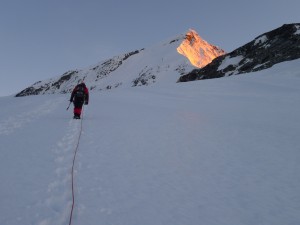New Zealand
 An alpine grading system adapted from the grades used in the Aoraki/Mt Cook Region is widely used in New Zealand for alpine routes in the North and South islands. Grades currently go from 1–7. The grading system is open ended; harder climbs are possible.
An alpine grading system adapted from the grades used in the Aoraki/Mt Cook Region is widely used in New Zealand for alpine routes in the North and South islands. Grades currently go from 1–7. The grading system is open ended; harder climbs are possible.
Factors which determine grade are (in descending order of contributing weight):
- technical difficulty,
- objective danger,
- length
- and access.
Standard grading system for alpine routes in normal conditions
- New Zealand Grade 1: Easy scramble. Use of rope generally only for glacier travel.
- New Zealand Grade 2: Steeper trickier sections may need a rope.
- New Zealand Grade 3: Longer steeper sections generally. Use of technical equipment necessary. Ice climbs may require two tools.
- New Zealand Grade 4: Technical climbing. Knowledge of how to place ice and rock gear quickly and efficiently a must. Involves a long day.
- New Zealand Grade 5: Sustained technical climbing. May have vertical sections on ice.
- New Zealand Grade 6: Multiple crux sections. Vertical ice may not have adequate protection. Good mental attitude and solid technique necessary. May require a bivy on route and be a long way from civilization.
- New Zealand Grade 7: Vertical ice/rock which may not have adequate protection. Rock grades in the high 20's (Ewbank). Climb may be in remote area. May require a bivy on route.
For reference to other grading systems please use the link ►
